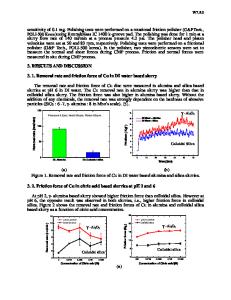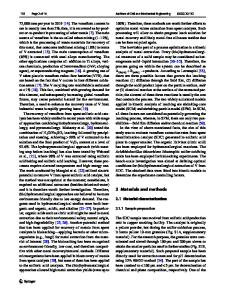Aqueous Ferrofluid of Citric Acid Coated Magnetite Particles
- PDF / 304,451 Bytes
- 6 Pages / 612 x 792 pts (letter) Page_size
- 31 Downloads / 306 Views
N6.6.1
Aqueous Ferrofluid of Citric Acid Coated Magnetite Particles A. Goodarzi1, Y. Sahoo2, M.T. Swihart1, P.N. Prasad2 1 Department of Chemical and Biological Engineering and Institute for Lasers, Photonics and Biophotonics, University at Buffalo (SUNY), Buffalo, NY, 14260 2 Department of Chemistry and Institute for Lasers, Photonics and Biophotonics, University at Buffalo (SUNY), Buffalo, NY, 14260
ABSTRACT Magnetic nanoparticles have found application in medical diagnostics such as magnetic resonance imaging and therapies such as cancer treatment. In these applications, it is imperative to have a biocompatible solvent such as water at optimum pH for possible bio-ingestion. In the present work, a synthetic methodology has been developed to get a well-dispersed and homogeneous aqueous suspension of Fe3O4 nanoparticles in the size range of 8-10 nm. The surface functionalization of the particles is provided by citric acid. The particles have been characterized using transmission electron microscopy, magnetization measurements with a superconducting quantum interference device, FTIR spectroscopy (for surfactant binding sites), thermogravimetric studies (for strength of surfactant binding), and x-ray photoelectron spectroscopy and x-ray diffraction (for composition and phase information). The carboxylate functionality on the surface provides an avenue for further surface modification with fluorescent dyes, hormone linkers etc for possible cell-binding, bioimaging, tracking, and targeting.
INTRODUCTION Magnetic nanoparticles have drawn much scientific interest for a variety of studies on topics including superparamagnetism[1], magnetic dipolar interactions[2], single electron transfer[3], magnetoresistance[4] and so on. One area that is particularly promising is the use of magnetic nanoparticle systems for probing and manipulating biological systems[5]. Magnetite (Fe3O4) nanoparticles have been widely studied, and their colloidal dispersion is a well-known ferrofluid that has many potential bio-medical applications. The particles, for this purpose, are subjected to suitable surface modifications by various coating agents such as dextran[6], dimercaptosuccinic acid [7,8], starch and methoxypoly(ethylene glycol)[9], protein[10], silica coating [11] etc. It is a technological challenge to acquire control over the nanoparticles’ sizes and dispersibility in desired solvents. Because of their large surface to volume ratio, nanoparticles possess high surface energies. The particles tend to aggregate to minimize total surface energy. In the case of metal oxide surfaces, such energies are in excess of 100 dyn/cm [12]. Because the particles are magnetic in nature, there is an additional contribution from inter-particle magnetic dipolar attraction that tends to destabilize the colloidal dispersion further. Suitable surface functionalization of the particles and choice of solvent are crucial to achieving sufficient repulsive interactions between particles to prevent aggregation and obtain a thermodynamically stable colloidal so
Data Loading...










